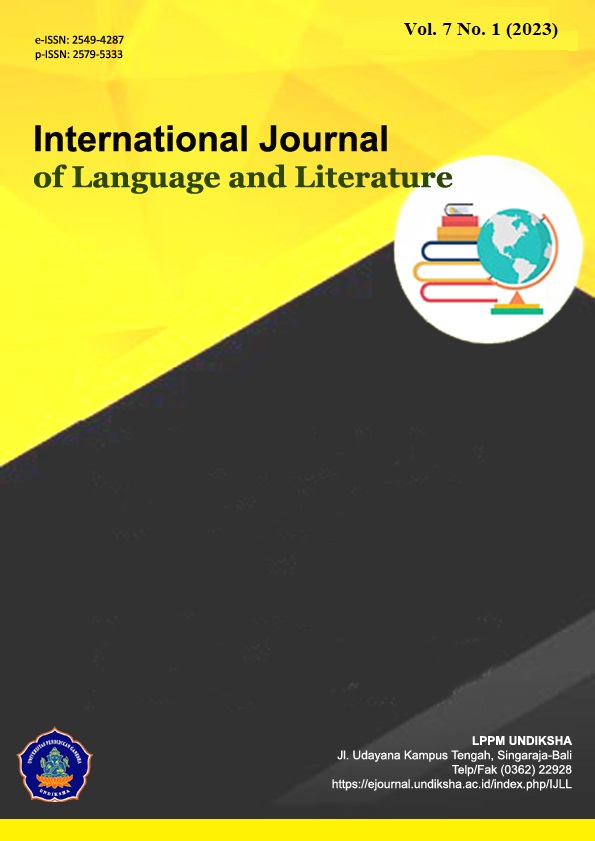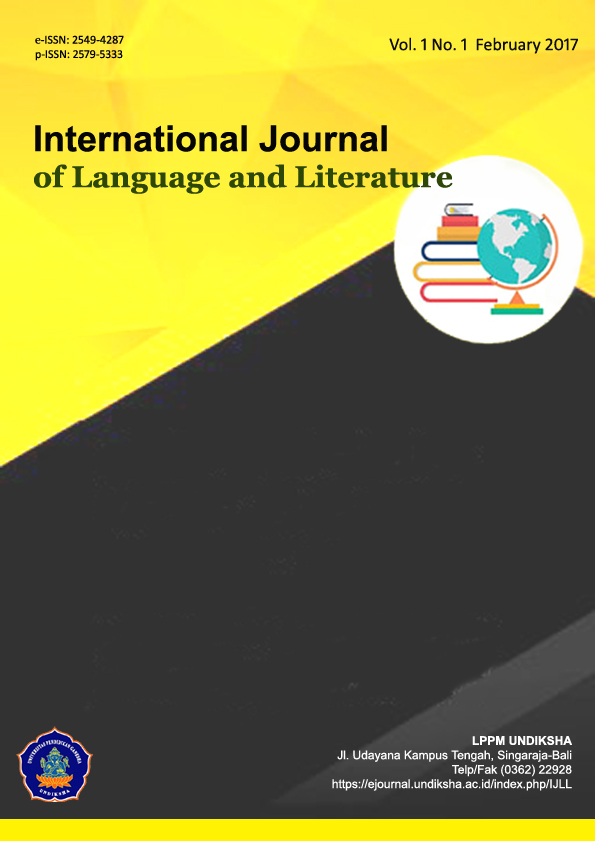Students’ Perception of Supporting Factors during Remote English Teaching
DOI:
https://doi.org/10.23887/ijll.v7i1.60687Keywords:
Students’ perception: English: Remote teaching: Supporting Factors:EFLAbstract
The covid-19 pandemic has made the traditional learning system distance learning. Some research outside the Indonesian context states that distance learning has become commonplace, but it is different from Indonesia. So that the supporting factors faced by students in carrying out remote teaching are different, especially in the Indonesian context. Since remote teaching was implemented, there have been many obstacles experienced by teachers and students in following the learning process. This study aims to analyze students' perceptions regarding the supporting factors for the implementation of remote teaching. This study uses mixed methods (qualitative and quantitative) which aims to analyze more valid and accurate data results. The focus of this research is 142 eleventh grade students who have carried out remote teaching. In data collection, researchers conducted literature studies, interviews and questionnaires. The results of this study show that there are ten factors supporting the implementation of distance learning found in the matrix literature review and confirmed by the subject. The supporting factors found can be used as guidelines for the government, teachers and students in implementing the distance learning process in the future.
References
Abdulamir, A. S., & Hafidh, R. R. (2020). The possible immunological pathways for the variable immunopathogenesis of COVID—19 infections among healthy adults, elderly and children. Electronic Journal of General Medicine, 17(4), 1–4. https://doi.org/10.29333/ejgm/7850. DOI: https://doi.org/10.29333/ejgm/7850
Adedoyin, O. B., & Soykan, E. (2020). Covid-19 pandemic and online learning: the challenges and opportunities. In Interactive Learning Environments (pp. 1–13). https://doi.org/10.1080/10494820.2020.1813180. DOI: https://doi.org/10.1080/10494820.2020.1813180
Akhwani, M. A. R. (2021). Pendidikan Karakter Masa Pandemi Covid-19 di SD. Indonesian Journal of Primary Education, 5(1), 1–12. http://repository.unusa.ac.id/6686/. DOI: https://doi.org/10.17509/ijpe.v5i1.31381
Alhamuddin, A., & Zebua, R. S. Y. (2021). Perceptions of Indonesian Students on the Role of Teachers in Offline and Online Learning During the Covid-19 Pandemic Period. Jurnal Kependidikan: Jurnal Hasil Penelitian Dan Kajian Kepustakaan Di Bidang Pendidikan, Pengajaran Dan Pembelajaran, 7(4), 834. https://doi.org/10.33394/jk.v7i4.3881. DOI: https://doi.org/10.33394/jk.v7i4.3881
Almeida, F. (2020). Strategies To Perform A Mixed Method Study. European Journal of Education Studies, 7(1), 326–337. https://doi.org/10.5281/zenodo.1406214.
Amin, F. M., & Sundarai, H. (2020). EFL students’ preferences on digital platforms during emergency remote teaching: Video, Conference, LMS, or Messenger Application ? Studies in English Language and Education, 7(2), 362–378. https://doi.org/10.24815/siele.v7i2.16929. DOI: https://doi.org/10.24815/siele.v7i2.16929
Antee, A. (2021). Student perceptions and mobile technology adoption: implications for lower-income students shifting to digital. Educational Technology Research and Development, 69(1), 191–194. https://doi.org/10.1007/s11423-020-09855-5. DOI: https://doi.org/10.1007/s11423-020-09855-5
Budi, & Nurjayanti, B. (2013). Pengembangan Metode Pembelajaran Online Berbasis E-learning (Studi Kasus Mata Kuliah Bahasa Pemrograman). Jurnal Sains Terapan, 53(9), 1689–1699. https://doi.org/10.29244/jstsv.2.1.59-66. DOI: https://doi.org/10.29244/jstsv.2.1.59-66
Cahyadi, A., Hendryadi, Widyastuti, S., Mufidah, V. N., & Achmadi. (2021). Emergency remote teaching evaluation of the higher education in Indonesia. Heliyon, 7(8), e07788. https://doi.org/https://doi.org/10.1016/j.heliyon.2021.e07788. DOI: https://doi.org/10.1016/j.heliyon.2021.e07788
Cahyani, A., Listiana, I. D., & Larasati, S. P. D. (2020). Motivasi Belajar Siswa SMA pada Pembelajaran Daring di Masa Pandemi Covid-19. IQ (Ilmu Al-Qur’an): Jurnal Pendidikan Islam, 3(01), 123–140. https://doi.org/10.37542/iq.v3i01.57. DOI: https://doi.org/10.37542/iq.v3i01.57
Carayannis, E. G., & Morawska-Jancelewicz, J. (2022). The Futures of Europe: Society 5.0 and Industry 5.0 as Driving Forces of Future Universities. Journal of the Knowledge Economy, 0123456789. https://doi.org/10.1007/s13132-021-00854-2. DOI: https://doi.org/10.1007/s13132-021-00854-2
Chen, Q., & Yan, Z. (2016). Does multitasking with mobile phones affect learning? A review. Computers in Human Behavior, 54, 34e42-42. https://doi.org/10.1016/j.chb.2015.07.047. DOI: https://doi.org/10.1016/j.chb.2015.07.047
Code, J., Ralph, R., & Forde, K. (2020). Pandemic designs for the future: perspectives of technology education teachers during COVID-19. Information and Learning Science, 121(5–6), 409–421. https://doi.org/10.1108/ILS-04-2020-0112. DOI: https://doi.org/10.1108/ILS-04-2020-0112
Cresswell, J. W. (2009). Research Design: Qualitative, Quantitative, and Mixed Methods Approaches (3rd ed.). SAGE Publications, Inc.
Felszeghy, S., Pasonen-Seppanen, S., Koskela, A., Nieminen, P., Harkonen, K., Paldanius, K. M. A., Gabbouj, S., Ketola, K., Hiltunen, M., Lundin, M., Haapaniemi, T., Sointu, E., Bauman, E. B., Gilbert, G. E., Morto, D., & Mahonen, A. (2019). Using Online Game-Based Platforms to Improve Student Performance and Engagement in Histology Teaching (Use of Gamification in a Histology Course: an Innovative Strategy). BMC Medical Education, 19(273), 1–11. https://doi.org/10.1186/s12909-019-1701-0. DOI: https://doi.org/10.1186/s12909-019-1701-0
Ferri, F., Grifoni, P., & Guzzo, T. (2020). Online learning and emergency remote teaching: Opportunities and challenges in emergency situations. Societies, 10(4), 86. https://doi.org/10.3390/soc10040086. DOI: https://doi.org/10.3390/soc10040086
Gamage, K. A. A., Wijesuriya, D. I., Ekanayake, S. Y., Rennie, A. E. W., Lambert, C. G., & Gunawardhana, N. (2020). Online delivery of teaching and laboratory practices: Continuity of university programmes during COVID-19 pandemic. Education Sciences, 10(10), 1–9. https://doi.org/10.3390/educsci10100291. DOI: https://doi.org/10.3390/educsci10100291
Ivanova, O., Gnatyshina, E., Uvarina, N., Korneeva, N., & Savchenkov, A. (2021). The wheel of science: A model for managing scientific activities in higher education as a factor in developing flexible skills of the youth in the region. Thinking Skills and Creativity, 42(August), 100928. https://doi.org/10.1016/j.tsc.2021.100928. DOI: https://doi.org/10.1016/j.tsc.2021.100928
Kartimi, Shidiq, A. S., & Nasrudin, D. (2021). The elementary teacher readiness toward stem-based contextual learning in 21st century era. Elementary Education Online, 20(1), 145–156. https://doi.org/10.17051/ilkonline.2021.01.019. DOI: https://doi.org/10.17051/ilkonline.2021.01.019
Le, V. T., Nguyen, N. H., Tran, T. L. N., Nguyen, L. T., Nguyen, T. A., & Nguyen, M. T. (2022). The interaction patterns of pandemic-initiated online teaching: How teachers adapted. System, 105(September 2020), 102755. https://doi.org/10.1016/j.system.2022.102755. DOI: https://doi.org/10.1016/j.system.2022.102755
Lusiyani, R., & Dara Anindya, W. (2021). Choosing and Using Learning Media during Remote Teaching: Teachers’ Thought. Journal of English Language Teaching and Linguistics) e-ISSN, 6(2), 2021. https://doi.org/10.21462/jeltl.v6i2.555. DOI: https://doi.org/10.21462/jeltl.v6i2.555
Mahsun, M., Ibad, T. N., & Nurissurur, A. (2021). Model Belajar Synchronous dan Ansynchronous Dalam Menghadapi Learning Loss. Bidayatuna Jurnal Pendidikan Guru Mandrasah Ibtidaiyah, 4(1), 123. https://doi.org/10.54471/bidayatuna.v4i1.1274. DOI: https://doi.org/10.54471/bidayatuna.v4i1.1274
Mayer, G., & Sekayi, D. (2018). Pedagogical Practices of Teaching Assistants in Polysynchronous Classrooms: The Role of Professional Autonomy. InSight: A Journal of Scholarly Teaching, 13, 130–149. https://doi.org/10.46504/14201807ma. DOI: https://doi.org/10.46504/14201807ma
Mu’awanah, N., Sumardi, S., & Suparno, S. (2021). Using Zoom to Support English Learning during Covid-19 Pandemic: Strengths and Challenges. Jurnal Ilmiah Sekolah Dasar, 5(2), 222. https://doi.org/10.23887/jisd.v5i2.35006. DOI: https://doi.org/10.23887/jisd.v5i2.35006
Muzaffar, A., Ragab Hassen, H., Lones, M. A., & Zantout, H. (2022). An in-depth review of machine learning based Android malware detection. Computers and Security, 121, 102833. https://doi.org/10.1016/j.cose.2022.102833. DOI: https://doi.org/10.1016/j.cose.2022.102833
Nugroho, A., Haghegh, M., & Triana, Y. (2021). Emergency remote teaching amidst global pandemic: voices of Indonesian EFL teachers. VELES: Voices of English Language Education Society, 5(1), 66–80. https://doi.org/10.29408/veles%20journal.v5i1.3258.
Núñez, J. A. L., Belmonte, J. L., Guerrero, A. J. M., & Sánchez, S. P. (2020). Effectiveness of innovate educational practices with flipped learning and remote sensing in earth and environmental sciences-An exploratory case study. Remote Sensing, 12(5). https://doi.org/10.3390/rs12050897. DOI: https://doi.org/10.3390/rs12050897
Nurhidayat, E. (2021). Utilizing Canva As Digital Tools To Teach Grammar in Remote Learning Period. Journal of English Language Learning, 5(2), 95–99. https://doi.org/10.31949/jell.v5i2.3413. DOI: https://doi.org/10.31949/jell.v5i2.3413
Nyudak, D. T., Putra, I. N. A. J., & Santosa, M. H. (2021). Investigating the Implementation of Online Learning in Remote Learning Context. Journal of Education Research and Evaluation, 5(2), 311. https://doi.org/10.23887/jere.v5i2.32857. DOI: https://doi.org/10.23887/jere.v5i2.32857
Rahiem, M. D. H. (2020). The emergency remote learning experience of university students in Indonesia amidst the COVID-19 crisis. International Journal of Learning, Teaching and Educational Research, 19(6), 1–26. https://doi.org/10.26803/ijlter.19.6.1. DOI: https://doi.org/10.26803/ijlter.19.6.1
Sari, D. W., & Khoiri, Q. (2023). Pendidikan untuk Semua: Studi pada Kebijakan Wajib Belajar 9 Tahun. Journal on Education, 5(3), 9441–9450. https://doi.org/10.31004/joe.v5i3.1757. DOI: https://doi.org/10.31004/joe.v5i3.1757
Sholihah, M., Ratnasari, K., Permatasari, Y. D., Muawanah, U., & Fajri, A. N. F. (2020). The policy of educators’ certification : An effort to improve quality, qualification, and teachers’ competence. IOP Conference Series: Earth and Environmental Science, 485(1). https://doi.org/10.1088/1755-1315/485/1/012130. DOI: https://doi.org/10.1088/1755-1315/485/1/012130
Surakarta, I. A. I. N., Nugroho, A., Haghegh, M., Cyprus, E. M. U. N., & Turkey. (2021). Emergency Remote Teaching amidst Global Pandemic: Voices of Indonesian EFL Teachers. VELES Voices of English Language Education Society, 5(1), 66–80. https://doi.org/10.29408/veles.v5i1.3258. DOI: https://doi.org/10.29408/veles.v5i1.3258
Talidong, K. J. B. (2020). Implementation of Emergency Remote Teaching (ERT) among Philippine Teachers in Xi’an, China. Asian Journal of Distance Education, 15(1), 196–201. https://eric.ed.gov/?id=EJ1290051.
Torres-Gastelú, C. A., & Kiss, G. (2016). Perceptions of students towards ICT competencies at the University. Informatics in Education, 15(2), 319–338. https://doi.org/10.15388/infedu.2016.16. DOI: https://doi.org/10.15388/infedu.2016.16
Valverde-Berrocoso, J., Fernández-Sánchez, M. R., Dominguez, F. I. R., & Sosa-Díaz, M. J. (2021). The educational integration of digital technologies preCovid-19: Lessons for teacher education. PLoS ONE, 16(8 August), 1–22. https://doi.org/10.1371/journal.pone.0256283. DOI: https://doi.org/10.1371/journal.pone.0256283
Wang, H., Buzzetto- Hollywood, N., Elobeid, M., & Elobaid, M. (2018). Addressing Information Literacy and the Digital Divide in Higher Education. Interdisciplinary Journal of E-Skills and Lifelong Learning, 14, 077–093. https://doi.org/10.28945/4029. DOI: https://doi.org/10.28945/4029
Yuliana, Y. (2020). Corona virus diseases (Covid-19): Sebuah tinjauan literatur. Wellness And Healthy Magazine, 2(1), 187–192. https://doi.org/10.30604/well.95212020. DOI: https://doi.org/10.30604/well.95212020
Zamora-Antuñano, M. A., Rodríguez-Reséndiz, J., Cruz-Pérez, M. A., Reséndíz, H. R., Paredes-García, W. J., & Díaz, J. A. G. (2022). Teachers’ perception in selecting virtual learning platforms: A case of mexican higher education during the COVID-19 crisis. Sustainability (Switzerland), 14(1). https://doi.org/10.3390/su14010195. DOI: https://doi.org/10.3390/su14010195
Downloads
Published
How to Cite
Issue
Section
License
Copyright (c) 2023 Made Emi Anggreyani -

This work is licensed under a Creative Commons Attribution-ShareAlike 4.0 International License.
IJLL Journal provides immediate open access to its content on the principle that making research freely available to the public to supports a greater global exchange of knowledge.

This work is licensed under a Creative Commons Attribution-ShareAlike 4.0 International License








